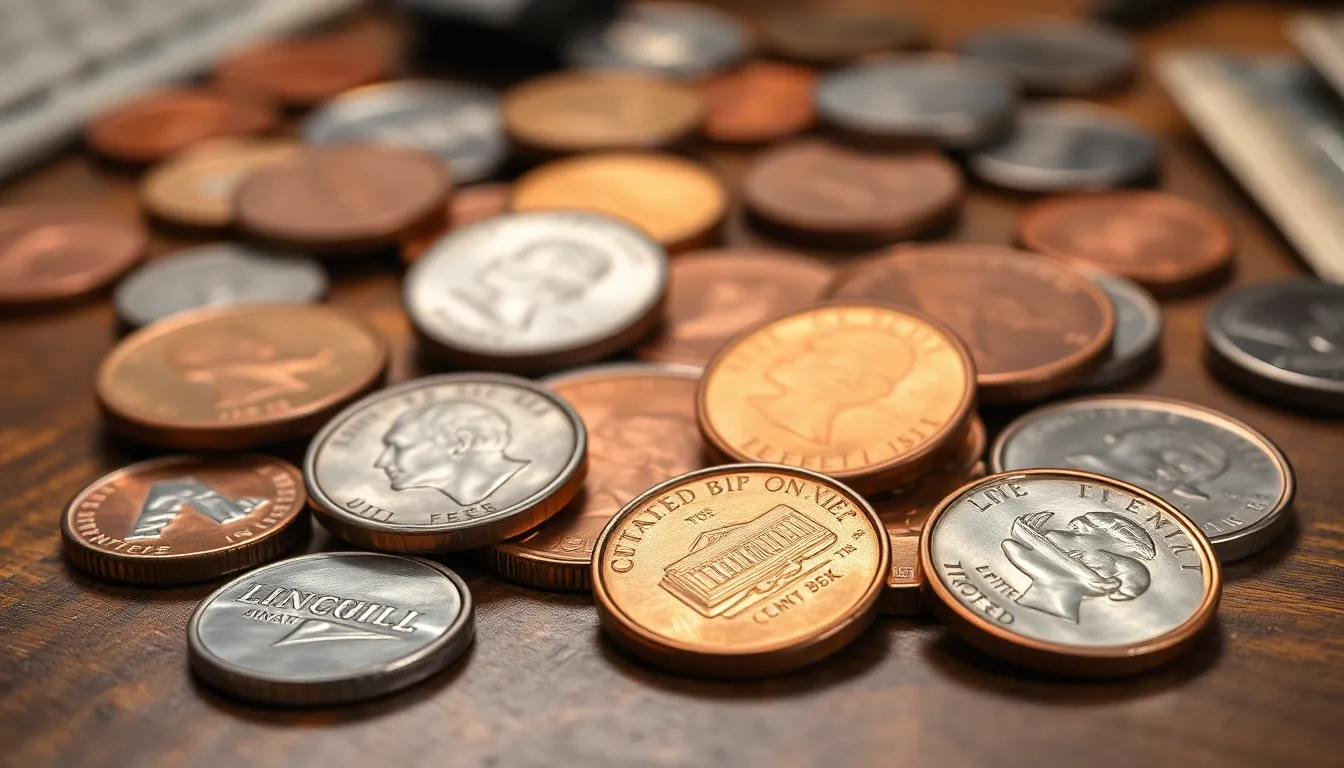In a world where spare change often gets tossed aside, modern pennies are hiding in plain sight, waiting to make their owners richer. Yes, you heard that right! Those little copper coins that usually end up in the couch cushions might actually be worth more than their face value. Who knew that a penny could be more than just a penny?
From rare minting errors to unique designs, some modern pennies have become unexpected treasures. They’re not just for wishing wells or vending machines anymore. So before you dismiss that shiny penny you find on the sidewalk, it might be time to take a closer look. After all, who wouldn’t want to turn a handful of pennies into a small fortune? Let’s dive into the world of modern pennies worth money and uncover what makes these tiny coins so valuable.
Table of Contents
ToggleUnderstanding Modern Pennies
Modern pennies might look unremarkable, yet some possess significant value due to specific features. Collectors recognize that rare minting errors or unique designs can elevate the worth of these coins far beyond one cent.
What Are Modern Pennies?
Modern pennies refer to those minted from 1982 to the present. These coins primarily consist of zinc with a thin copper plating. Collectors often seek varieties such as the 1983 bronze penny, which resembles an earlier composition. Other noteworthy examples include the 1995 double die obverse and the 2009 Lincoln Bicentennial issues. Market demand drives their valuation, making keen observations essential for any collector.
Brief History of U.S. Pennies
The first U.S. penny, known as the 1793 Chain Cent, marked the start of a long tradition. Throughout history, multiple designs have emerged, including the Lincoln penny introduced in 1909, which honors President Abraham Lincoln. Significant changes occurred in 1982, when the mint transitioned to zinc-based coins to reduce costs. This switch created a notable distinction between pre-1982 and post-1982 pennies regarding composition. Understanding this historical context assists collectors in determining the potential value of modern pennies.
Identifying Valuable Modern Pennies

Identifying valuable modern pennies involves recognizing specific traits and markings that signal higher worth. Collectors focus on minting errors and unique features that boost market value.
Key Characteristics of Worthwhile Pennies
Rare minting errors often define valuable pennies. For instance, those with off-center strikes or double die varieties can fetch higher prices. Condition greatly affects value; uncirculated pennies stand out due to their pristine appearance. Moreover, specific years also matter, like the 1983 bronze penny, which is worth much more than its face value. Collectors actively search for these characteristics, so understanding them aids in identifying potentially valuable coins.
Mint Marks and Their Importance
Mint marks play a crucial role in determining a penny’s worth. Every penny produces a mint mark that indicates its origin. For example, a penny featuring the “S” mint mark signifies its production in San Francisco, while those without a mark were minted in Philadelphia. Certain mint marks, such as the “D” from Denver, can also enhance a penny’s value. Collectors value these distinctions, as mint marks often reflect rarity and collector demand, contributing significantly to overall worth.
Types of Modern Pennies Worth Money
Certain modern pennies, often dismissed, hold significant value due to unique characteristics or minting errors. Collectors and enthusiasts particularly focus on a few noteworthy types.
1982 Copper Penny
The 1982 copper penny remains a rare find among collectors. Minted with a composition of 95% copper and only 5% zinc, it contrasts with the later zinc-based pennies. Most 1982 pennies are zinc, making copper versions highly sought after, with values exceeding $1,000 in uncirculated condition. Determining authenticity requires careful examination, as only a small number were produced before the switch in composition occurred.
1995 Double Die Penny
Notable for its striking design, the 1995 double die penny features a prominent doubling effect, particularly visible in the lettering. This penny’s unique error arises from the die used during minting, leading to multiple impressions. Collectors value the 1995 double die penny significantly, with prices ranging from $300 to over $1,000 for coins in excellent condition. Identifying genuine double dies involves checking for the distinct doubling on the date and “Liberty.”
2021 Reverse-Designed Penny
The 2021 reverse-designed penny stands out due to its commemorative nature linked to the 100th anniversary of the Lincoln penny. This coin features a unique design element that appeals to collectors, especially in uncirculated condition. Due to limited availability, the 2021 reverse-designed penny can fetch prices around $5 to $15. Recognizing this coin involves understanding the design variations and its place in commemorating a significant historical milestone.
How to Determine the Value of Your Pennies
Determining the value of modern pennies requires attention to detail and an understanding of grading systems.
Grading and Condition
Condition plays a crucial role in assessing a penny’s value. Collectors categorize coins using a grading scale, typically from Poor to Brilliant Uncirculated. Factors affecting grade include wear, scratches, and overall appearance. Coins in uncirculated condition hold the highest value, often commanding prices above their face value. Collectors consistently seek out coins with minimal signs of wear. A penny that appears bright and fresh frequently attracts higher bids. Additionally, the presence of mint marks can further influence the grade and therefore the value.
Resources for Valuation
Several resources provide excellent information for valuing modern pennies. Websites like CoinTrackers and PCGS offer online valuation tools. These platforms give up-to-date market prices based on recent sales data. Additionally, price guides, like the Red Book, provide comprehensive information on various penny types and their typical values. Joining online forums fosters community engagement, allowing collectors to share insights and experiences. Local coin shops often offer assessments, providing hands-on evaluation for penny collections. These resources equip collectors with essential knowledge to make informed decisions regarding their pennies.
Modern pennies hold hidden value that many overlook. By understanding the unique traits and rare minting errors of certain coins, collectors can uncover potential treasures in their spare change. The market for these coins is dynamic and driven by demand, making it essential for collectors to stay informed.
Recognizing valuable varieties and grading conditions is vital in maximizing the worth of a penny collection. Whether it’s the elusive 1982 copper penny or the striking 1995 double die, these coins can transform a simple collection into a worthwhile investment. With the right knowledge and resources, anyone can embark on a rewarding journey in the world of modern penny collecting.


